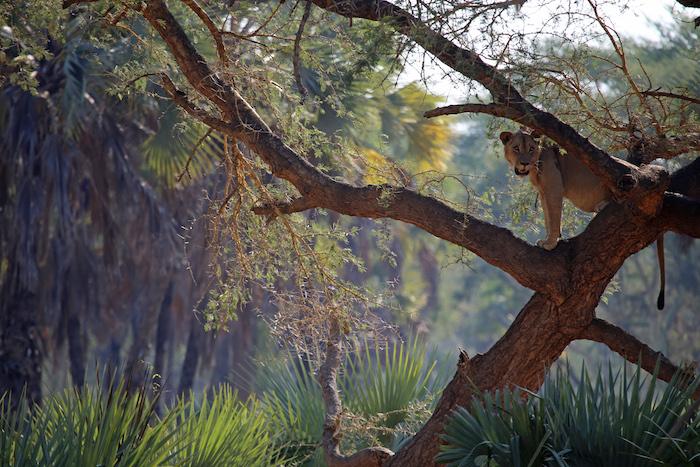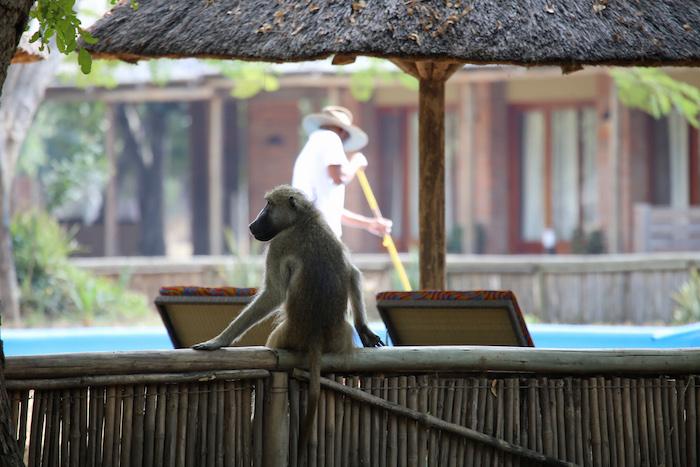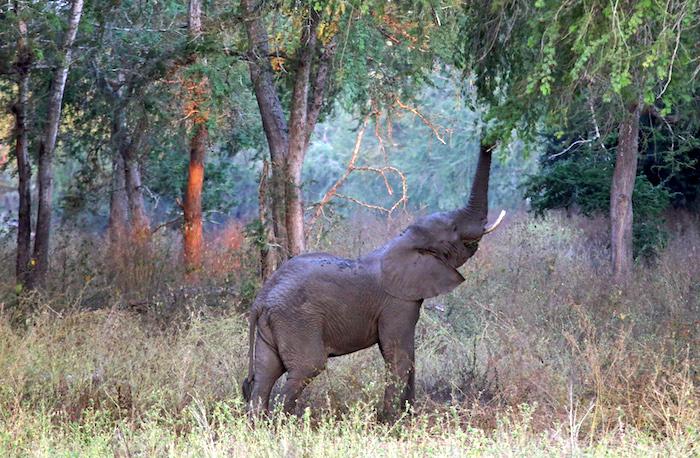
Though still low in numbers, lion populations are slowly coming back in Gorongosa/Barbara J. Moritsch
How did I miss what may be the largest, most significant ecological restoration project ever to occur in a national park?
How did I miss what premier biologist E.O. Wilson claims is, ecologically, the most diverse park in the world? I’m an ecologist; much of my career has focused on habitat restoration. I read a lot. I pay attention to environmental news. And I fell under the spell of Africa in 1995, when I visited Kenya, and again in 2005, while exploring Tanzania. So, how did I miss Gorongosa?
The advertising world claims a person must be exposed to a product numerous times before a purchase is likely. This concept must apply to other aspects of life as well. In 2009, I met Jane Goodall at a reception hosted by Zoo Boise. During the presentation that followed, Mozambique’s Gorongosa National Park was discussed. In 2014, I spotted a new book by E. O. Wilson at Barnes and Noble: A Window on Eternity: A Biologist’s Walk Through Gorongosa National Park. Finally, this past February, I saw a Zoo Boise newsletter announcing a trip to the park. I knew right away I had to go. Now, after an extraordinary experience, I am missing Gorongosa in an entirely different way.
The sun had set by the time we turned off the paved road into the park. Our group of 13 had flown from Johannesburg, South Africa, to the coastal city of Beira, Mozambique, and then driven for several hours. The park’s dirt road seemed endless, and the darkness framing the van’s headlights was absolute. Mesmerized by the rhythm of tires rolling over washboard ruts, I was disoriented by movement on the road ahead. I struggled to process the information: Africa, large animals with dark bodies, stout curled horns. “Cape buffalo,” I announced. The driver stopped the van, and we silently watched the dozen or so animals amble out of sight, leaving a lazy cloud of dust in the headlights’ beam.
Had we visited ten years earlier, in 2005, we would not have been greeted by buffalo. In fact, between 1992 and 2005, visitors would have seen little or no wildlife. If we’d come 50 years earlier, though, around 1965, we would have witnessed thriving populations of numerous species. Wildlife surveys from the 1960s and ‘70s revealed up to 500 lions, thousands of buffalo, elephants, wildebeest, zebra, waterbuck, impala, and hippos, as well as large herds of eland, sable and hartebeest. But, a 1994 survey revealed only 100 elephants, 300 reedbuck, 100 waterbuck, and a handful of zebra and small antelope. The huge declines were the result of war.

Recovery from the wars is obvious in that wildlife is much more visible in Gorongosa/Barbara Moritsch
The War of Independence between Portugal and the Mozambique Liberation Front (Frelimo), lasted from 1964 to 1974, but had little impact on the park. Two years later, a much more damaging conflict erupted. For 16 years (1977-1992), the Frelimo-led government clashed with the Mozambique National Resistance group, Renamo. Animals were slaughtered for food and ivory, the latter sold to finance the war. Professional hunters also slaughtered wildlife for the next several years. Approximately one million Mozambicans were killed, and most of Gorongosa’s animals were destroyed. In 1992, Mozambique was considered the world’s poorest country. After waving goodbye to the night buffalo, we continued to the park’s main camp, Chitengo, and received a warm welcome from the Girassol Gorongosa Lodge staff. After depositing my bags, I found the restaurant, and was immediately pulled into a round of introductions with several park staffers. At the center of the circle stood Greg Carr, dressed in khaki shorts and a blue T-shirt sporting a Gorongosa National Park emblem.
He greeted us all with sparkling eyes, a broad smile, and a handshake. An Idaho native, and an extremely astute businessman and philanthropist, Carr is the driving force behind Gorongosa’s restoration. He visited Mozambique and the park in 2004 while searching for a project that would significantly benefit people. Recognizing Gorongosa’s potential to once again become a safe haven for wildlife as well as an economic engine for local communities, he began investing in the park. In 2008, he launched the multi-million-dollar Gorongosa Restoration Project, establishing a 20-year agreement with the Mozambican government to restore and protect the million-acre park while benefiting approximately 250,000 people living within the park or its 1.3-million-acre buffer zone.
In 2007, on a separate path, but with similar wildlife conservation goals, Steve Burns (Director, Zoo Boise and current Chair of the Board, Association of Zoos and Aquariums) started something new at the Idaho zoo—a fee (25¢ at first, then 50¢) added to the admission price to fund conservation projects. This shifted the nature of a zoo visit: Visitors now help the very animals they are seeing. Conservation fees also were added to zoo memberships and to special activities like feeding giraffes and taking a cruise to see monkeys. To date, fees have generated more than $1.7 million for local and global wildlife conservation. After Burns visited Gorongosa in 2008, the park became a key recipient of Zoo Boise’s conservation dollars. For the last three years, the zoo has provided $200,000 per year to support Gorongosa’s wildlife and community support programs.

Gorongosa National Park continues to recover from wounds inflicted during the wars. Elephants are particularly wary of humans in light of the losses they endured. But restoration efforts are proceeding/Barbara Moritsch
Thanks in large part to Zoo Boise, our group was immersed in all things Gorongosa for a full week. The first wildlife adventure involved a quest with Greg Carr to see elephants. I’d seen them in Kenya and Tanzania, but this was the first time my friend, Janette, had visited Africa. As we cruised east in the Jeep, with the sun descending behind us and the African fan palm forests closing in around us, Greg explained that Gorongosa’s elephants sometimes charged vehicles. He said if we encountered them close to the road he might have to take evasive action, so we should sit down and hold on. We were to tell him where the elephants were at all times so he could keep us at a safe distance. I thought he was exaggerating, being overly dramatic for our benefit. The numerous elephants I’d seen in Africa had come close to vehicles, and had never seemed aggressive. Much to Janette’s delight, we saw a few pairs of elephants, at quite a distance.
We emerged from the forest onto the edge of the Lake Urema floodplain, where we enjoyed our “sundowner.” Wine was poured, gin and tonics were stirred, and we raised our glasses to toast the spectacular red-orange sunset, the thousands of birds and ungulates visible across the floodplain, and new friends, all from the balcony of an old bombed-out structure known as Hippo House, once an upscale restaurant frequented by park visitors.
It was nearly dark when we left Hippo House. Once again, Greg mentioned the elephants. We entered the palm forest, came around a curve, and suddenly the air exploded in a trumpeted bellow. The first warning was followed by a second. A solo male elephant stood no more than 50 feet to our left, trunk in the air, tusks gleaming, big ears waving. Greg drove on, quickly. The elephant stood his ground.
We experienced a similar charge later in the week, and our guide explained the situation. Elephants can live 60 to 70 years, so many of these individuals witnessed horrific atrocities perpetrated on their friends and family members during the war. Humans are perceived to be enemies and must be driven off. And these older elephants are likely teaching their offspring to charge vehicles as well. The guides and elephant researchers are trying to work with the traumatized animals, giving them time to understand that people no longer seek to harm them.

Game drives enable park visitors to get out into several different habitat types in Gorongosa and spot wildlife, such as elephants/Barbara J. Moritsch
The next day, we tracked lions with the park’s lead lion researcher. The dry season was well advanced as we navigated through scattered stands of fan palm and stunning yellow-trunked acacias known as fever trees. We traversed broad expanses of grass— crisp, cream-colored, and often taller than the Land Cruisers. Using data transmitted from one lion’s collar, we honed in on the Sungue pride, lounging in the sun in a grassy, rock-studded clearing, blending well with the tawny background. Researchers believe there are currently about 50 lions in the park, compared to 500 before the wars, and five or fewer after the civil war ended.
With respect to recovery of other species, reintroductions began in 2006 with 54 buffalo obtained from Kruger National Park. Since that time, a total of 186 buffalo, 180 wildebeest, 35 eland, 15 zebra, 6 elephants, 5 hippos, and 4 cheetahs have been reintroduced. These actions helped Gorongosa’s recovery, but, according to Marc Stalmans, director of Scientific Services, the big story is how few animals have actually been re-introduced, and how much of the recovery has been through rapid growth of the small populations that remained after the war. Fewer than 500 animals have been re-introduced—all species whose remaining numbers were very small. Future plans call for more zebra, then tsessebe and roan antelope (both were totally extirpated), black and white rhino (but only when substantial progress has been made in combating international rhino poaching syndicates), and possibly spotted hyena and leopard. Recent surveys, according to Stalmans, indicate all large herbivore species, with the exception of zebra, now occur in numbers sufficient for continued recovery and viability. An aerial survey conducted in late October and early November of 2014 documented over 71,000 hoofed animals and 1,582 crocodiles. Lion recovery is slower than expected, based on prey availability. Researchers are determining the limiting factors, one of which appears to be poacher’s snares.

Elephants are becoming more and more visible around the park/Barbara Moritsch
In addition to wildlife watching, we visited the park’s Community Education Center, an impressive “green” facility completed in 2010, and we toured the new E. O. Wilson Biodiversity Laboratory, a base for long-term research and training opportunities in biodiversity documentation, ecology, and conservation biology. We also took a short hike and boat ride (powered by one man with a long pole) across the Pungue River to Vinho, a community near the park boundary. In Vinho, the Gorongosa Restoration Project constructed a school and medical clinic, and is promoting sustainable agriculture, as well as reducing conflicts between villagers and wildlife.
Toward week’s end, we hiked the flanks of Mount Gorongosa to search for the rare endemic green-headed oriole (which we saw!), and to tour a sustainable coffee farm designed to enhance economic development for people living near the mountain, and to help them shift away from slash-and-burn agriculture, which threatens the rain forest that cloaks the mountain slopes. In 2010, Greg Carr helped get Mount Gorongosa added to the park—the ecological health of the mountain is critical to the hydrological functioning of the park.
The night before our last day, Steve asked if anyone was interested in a helicopter tour the following day. I was ecstatic; a low-elevation flight over a national park in Africa was a dream come true. The flight was all I had hoped for and more. The broad landscape unfolded as the sun rose. The river network flowed into floodplains, which flowed into grasslands and forests, all teeming with wildlife. The waterways hosted dozens of huge crocodiles (one of the few species little affected by the war), and a huge clump of slumbering hippos. Elephants trotted through the palms, hundreds of waterbucks and other antelope grazed or wandered in search of food, and groups of storks, cranes, pelicans, and other assorted waterbirds flew in all directions. Simply put, life does not get any better.
I dreamed of Gorongosa every night for two weeks after returning home. As Steve said, the place gets under your skin. I am missing Gorongosa once again—this time I know what I am missing, and I will return. The land, the wildlife, and the people are all very compelling, but I think what makes Gorongosa different from other places I’ve visited in Africa relates to Greg Carr’s stated dream: “That we can achieve human development and biodiversity protection at the same time.” It’s a great dream unfolding, and the work in progress is a model applicable to national parks and wildlands worldwide.
Barbara Moritsch worked for the National Park Service as an ecologist and interpretive naturalist in five Western parks, including Yosemite. She holds Bachelor's and Master's degrees in natural resources and environmental science. She is the author of The Soul of Yosemite: Finding, Defending, and Saving the Valley's Sacred Wild Nature
Traveler Footnote: Watch Sunday for Jean Bjerke's piece on wildlife watching in Kenya's national parks and game reserves.



Comments
Stunning. Thank you, Barbara, for sharing this with us. I'd never heard of Gorongosa. The last part of the story especially struck me: ". . . Greg Carr's stated dream: "That we can achieve human development and biodiversity protection at the same time." It's a great dream unfolding, and the work in progress is a model applicable to national parks and wildlands worldwide.
Wouldn't that be wonderful?
Thank you, Lee! Greg Carr's work at Gorongosa provides an incredible model for parks and protected areas across the globe--truly inspiring!
Very intersting and encouraging. I visited Masai Mara in Kenya in the early 80s and have read the reports of declining wildlife populations in Africa in general with sadness and alarm, so it;s nice to read simething positive!